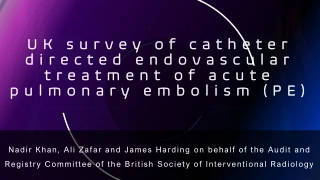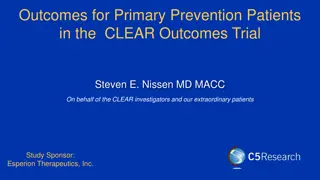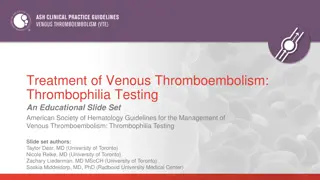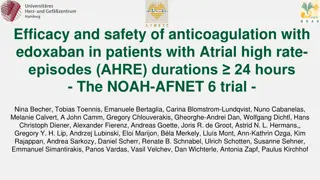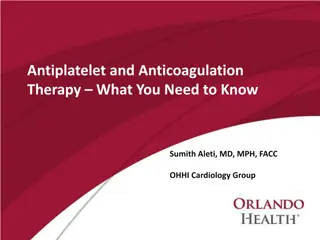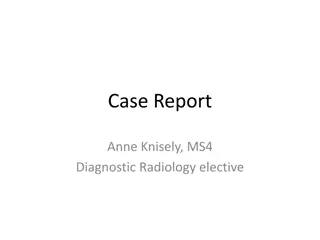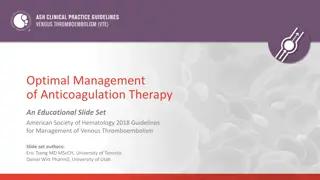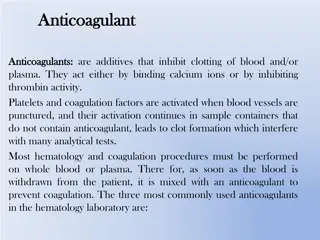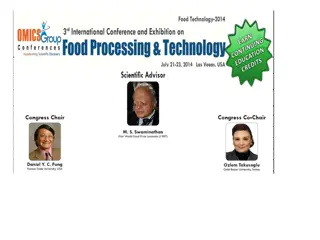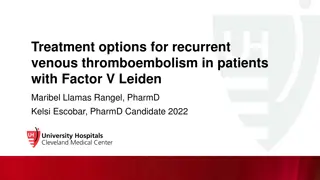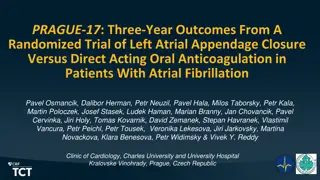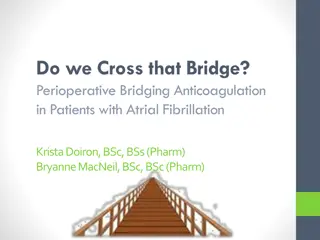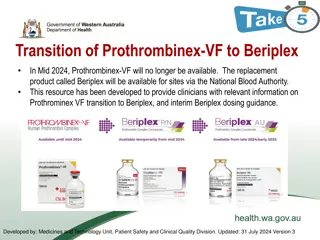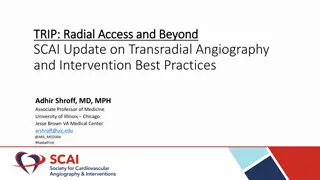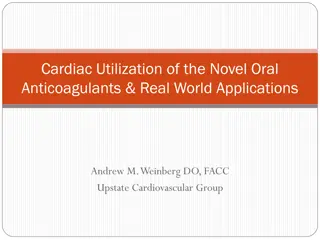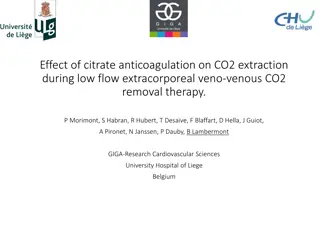UK Survey on Endovascular Treatment of Acute Pulmonary Embolism
Acute pulmonary embolism (PE) is a significant issue in hospitalized patients, with current treatments focusing on anticoagulation and systemic thrombolysis. Surgical treatments have shown poor outcomes, leading to a rise in endovascular techniques aimed at reducing clot burden. A survey conducted i
0 views • 12 slides
Understanding Paroxysmal Nocturnal Hemoglobinuria (PNH)
Paroxysmal Nocturnal Hemoglobinuria (PNH) is a rare blood disorder characterized by the destruction of red blood cells in the bloodstream, leading to anemia, hemoglobinuria, jaundice, and other symptoms. It is often challenging to diagnose due to its rarity. PNH can be a thrombophilic state, causing
0 views • 20 slides
CLEAR Outcomes Trial: Bempedoic Acid for Cardiovascular Prevention
The CLEAR Outcomes Trial investigated the effects of bempedoic acid, an ATP citrate lyase inhibitor, on cardiovascular outcomes in primary prevention patients. Results showed a reduction in cardiovascular events with bempedoic acid, particularly in patients intolerant to statins. Baseline characteri
0 views • 13 slides
Guidelines for Thrombophilia Testing in Venous Thromboembolism Management
The American Society of Hematology (ASH) provides comprehensive guidelines for the management of venous thromboembolism (VTE) with a focus on thrombophilia testing. Expert panels develop recommendations based on clinical questions, evidence synthesis, and resource use. These guidelines cover various
2 views • 47 slides
Efficacy and Safety of Anticoagulation with Edoxaban in Patients with AHRE Durations ≥24 Hours: The NOAH-AFNET 6 Trial
A prespecified subanalysis of the NOAH-AFNET 6 trial evaluated the efficacy and safety of edoxaban anticoagulation in patients with Atrial High-Rate Episodes (AHRE) lasting 24 hours compared to shorter episodes. Findings suggest that oral anticoagulation with edoxaban does not significantly reduce t
0 views • 13 slides
Understanding Antiplatelet and Anticoagulation Therapy in Cardiology
This informative content covers the current practice guidelines and medication options for antiplatelet therapy in CAD patients, discussing different medications, optimal duration of therapy, CV risk assessment, and anticoagulation options in atrial fibrillation. It delves into the role of aspirin i
0 views • 31 slides
Case Report: Submassive Bilateral Pulmonary Embolism in a 69-Year-Old Female
Anne Knisely, a 69-year-old female with a history of endometrial cancer, presented with left leg pain, pleuritic chest pain, and shortness of breath. Imaging revealed extensive bilateral pulmonary emboli, right heart strain, and lower extremity deep vein thrombi. She was managed with anticoagulation
3 views • 11 slides
Overview of Veterinary Clinical Pathology and Importance of Anticoagulants
Veterinary clinical pathology involves the laboratory diagnostics and analysis of bodily fluids and tissues to support the diagnosis, treatment, and prevention of diseases. This field encompasses interpreting blood tests, blood smear examinations, and the use of various anticoagulants in specimen co
2 views • 46 slides
Optimal Management of Anticoagulation Therapy - ASH 2018 Guidelines
The American Society of Hematology (ASH) 2018 guidelines focus on the optimal management of anticoagulation therapy, specifically in the context of venous thromboembolism (VTE). The guidelines cover topics such as prevention, treatment, and management strategies, developed through thorough panel for
0 views • 43 slides
Guidelines for Management of Pediatric Venous Thromboembolism
This educational slide set presents the American Society of Hematology's 2018 guidelines for the treatment of pediatric venous thromboembolism. The guidelines cover various aspects such as prevention, treatment, and optimal management of anticoagulation therapy in pediatric patients. Panels were for
0 views • 47 slides
Understanding Anticoagulants in Laboratory Hematology
Anticoagulants are crucial additives that prevent blood clotting during laboratory procedures. The commonly used anticoagulants include EDTA, sodium citrate, and heparin, each with specific concentrations, modes of action, and color-coded identifications. EDTA is ideal for blood cell counts, sodium
0 views • 6 slides
Optimal Management of Anticoagulation Therapy: ASH 2018 Guidelines
Educational slide sets and clinical guidelines by the American Society of Hematology (ASH) provide recommendations for the management of venous thromboembolism, including the optimal use of anticoagulation therapy. The guidelines detail panel formation criteria, development process, evidence synthes
0 views • 43 slides
Advances in Anticoagulation Therapy for Cancer-Related VTE and Stroke
Recent studies have shown advancements in anticoagulation therapy for cancer patients with venous thromboembolism (VTE) and stroke prevention. Direct oral anticoagulants (DOACs) are now considered beneficial for treating VTE in cancer, offering advantages in administration and efficacy. Different an
3 views • 9 slides
Effect of Processing Methods on Catfish Nutritional Quality
Fish, particularly catfish, serves as a vital protein source in West Africa. This study examines the impact of different processing methods, including the use of preservatives like sodium citrate and black pepper, on the nutritional quality, microbial status, and sensory attributes of smoked catfish
0 views • 29 slides
Treatment Strategies for Recurrent Venous Thromboembolism in Factor V Leiden Patients
This presentation discusses the treatment options for recurrent venous thromboembolism in patients with Factor V Leiden mutation. It explores the pathophysiology, epidemiology, and diagnosis criteria for Factor V Leiden, reviews failed anticoagulation history, and suggests outpatient anticoagulation
0 views • 31 slides
Three-Year Outcomes of Left Atrial Appendage Closure vs. Oral Anticoagulation in Atrial Fibrillation
The PRAGUE-17 study compares the three-year outcomes of left atrial appendage closure (LAAC) versus direct oral anticoagulation in patients with atrial fibrillation. LAAC was found to be non-inferior to NOACs for the primary composite endpoint, with similar incidence rates for secondary endpoints. T
0 views • 21 slides
Perioperative Anticoagulation in Atrial Fibrillation Patients
A thorough exploration of perioperative bridging anticoagulation in patients with atrial fibrillation, discussing the benefits of anticoagulation, therapeutic options, comparison of literature, and application in moderate-risk patients. The use of warfarin in atrial fibrillation treatment, standard
0 views • 39 slides
Transition from Prothrombinex-VF to Beriplex: Information and Guidance
In mid-2024, Prothrombinex-VF will be replaced by Beriplex, with the transition occurring in two stages. Beriplex P/N will be interim until Beriplex AU is available, with identical compositions. Clinicians are provided with dosing guidance for Beriplex, and the WA Anticoagulation Chart has been upda
0 views • 7 slides
Best Practices for Transradial Angiography and Intervention
This update highlights best practices for transradial angiography and intervention, including topics such as ultrasound guidance for transradial access, ulnar artery access recommendations, and future study opportunities. The importance of developing proficiency with ultrasound guidance, utilizing r
0 views • 15 slides
Understanding Cardiac Utilization of Novel Oral Anticoagulants
Dive into the realm of cardiac anticoagulation, exploring the evolution from traditional methods like Warfarin to the modern use of Novel Oral Anticoagulants (NOACs). Discover the indications for long-term anticoagulation in conditions like atrial fibrillation and mechanical heart valves. Delve into
0 views • 46 slides
Effect of Citrate Anticoagulation on CO2 Extraction in Low Flow Extracorporeal Venovenous CO2 Removal Therapy
This study evaluates the impact of citrate anticoagulation on CO2 extraction during low flow extracorporeal veno-venous CO2 removal therapy. The experiment conducted on a pig model comparing citrate anticoagulation to standard heparin protocol showed a trend towards improved CO2 extraction with citr
0 views • 6 slides
